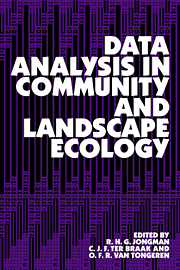Book contents
5 - Ordination
Published online by Cambridge University Press: 11 October 2009
Summary
Introduction
Aim and usage
Ordination is the collective term for multivariate techniques that arrange sites along axes on the basis of data on species composition. The term ordination was introduced by Goodall (1954) and, in this sense, stems from the German ‘Ordnung’, which was used by Ramensky (1930) to describe this approach.
The result of ordination in two dimensions (two axes) is a diagram in which sites are represented by points in two-dimensional space. The aim of ordination is to arrange the points such that points that are close together correspond to sites that are similar in species composition, and points that are far apart correspond to sites that are dissimilar in species composition. The diagram is a graphical summary of data, as in Figure 5.1, which shows three groups of similar sites. Ordination includes what psychologists and statisticians refer to as multidimensional scaling, component analysis, factor analysis and latent-structure analysis.
Figure 5.1 also shows how ordination is used in ecological research. Ecosystems are complex: they consist of many interacting biotic and abiotic components. The way in which abiotic environmental variables influence biotic composition is often explored in the following way. First, one samples a set of sites and records which species occur there and in what quantity (abundance). Since the number of species is usually large, one then uses ordination to summarize and arrange the data in an ordination diagram, which is then interpreted in the light of whatever is known about the environment at the sites.
- Type
- Chapter
- Information
- Data Analysis in Community and Landscape Ecology , pp. 91 - 173Publisher: Cambridge University PressPrint publication year: 1995
- 440
- Cited by

